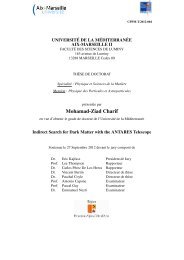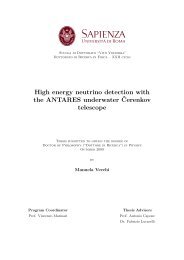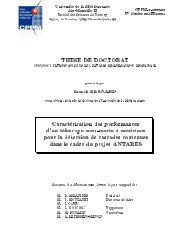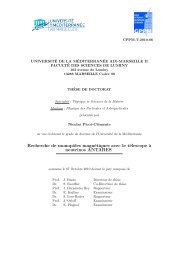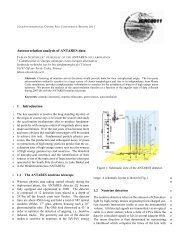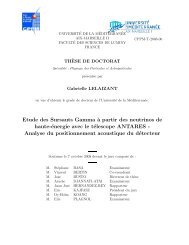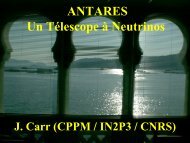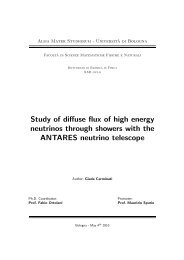Chapter 10: Management and quality assurance - Antares - IN2P3
Chapter 10: Management and quality assurance - Antares - IN2P3
Chapter 10: Management and quality assurance - Antares - IN2P3
Create successful ePaper yourself
Turn your PDF publications into a flip-book with our unique Google optimized e-Paper software.
constraints.Design ReviewEvaluation of the design will be implemented with a technical design review by experts that arenot associated with the ANTARES project. The TDR will form the basis of the evaluation.Procurement <strong>and</strong> manufacturingComponents <strong>and</strong> materials will be selected for best possible MTBF compatible with availability<strong>and</strong> acceptable price. Component lists <strong>and</strong> the rationale for their selection are included in the TDR.The present engineering design is based on extensive know-how obtained in previous deep-seaexperiments <strong>and</strong> prototype tests. In particular the recent Demonstrator Line experiment has shownthat:● Launching of a set of interconnected storeys equipped with Optical modules is wellmastered, i.e. OM-integrity OK, connectors <strong>and</strong> connecting cables intact.● Connection on deck of the vessel to an EOC is under control.● Short term (several months) corrosion is not an issue.● The acoustic positioning system satisfies specifications.● Adequate time reserved for <strong>quality</strong> <strong>assurance</strong>, system integration <strong>and</strong> strict respect forprocedures is indispensable.For the interfaces of mechanical, metallic parts, material combinations will be selected tominimise contact potentials <strong>and</strong> galvanic corrosion. An example is given in the chapter onMechanics, where the Junction Box configuration is described. In the production process of the JB,a <strong>quality</strong> <strong>assurance</strong> programme will be implemented by the industrial manufacturer. In this case,where a single-point-failure risk is involved, control of the QA-programme implementation will beensured by an independent expert firm.In order to prevent major delays during fabrication, integration <strong>and</strong> testing, a spare part policy of5-<strong>10</strong> % of the baseline amount of components will be applied.The procurement of a spare Junction Box is not considered feasible in the current phase of theproject.System integration <strong>and</strong> testingTesting of sub-systems comprises two major phases:1. Functional tests of electronics boards, which will be subjected to a sequence of environmentalconditions that exceed operational end-use specification in an Accelerated Stress Testing (AST)procedure. The purpose of applying AST is to eliminate most of the faulty items associated with the"infant mortality" phase of the st<strong>and</strong>ard reliability-versus-time curve.The scenario of AST for the LCM electronics has been established as follows:● Temperature cycling from <strong>10</strong>-40 °C with four cycles of 2 hours● Vibration with 3g acceleration at 50 Hz for 30 minutesCompliance with functional specifications after AST will be assessed <strong>and</strong> documented. SimilarAST scenarios apply to other objects - see the relevant chapters in this TDR. Once product <strong>quality</strong>has been assured with AST on item level, the prototype of a set of objects assembled into asub-system (e.g. the LCM electronics) is subjected to a qualification test to anticipate upcomingenvironmental conditions.Page <strong>10</strong>-7



